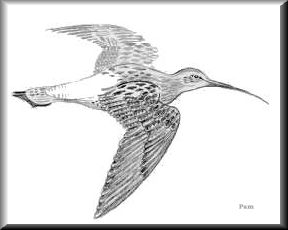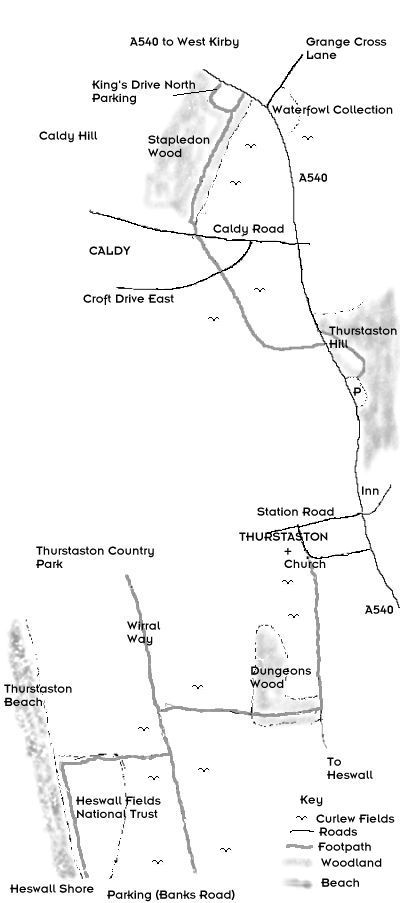| A Curlew Walk | |
 |
| Newsletter |
| A Curlew Walk | |
 |
| At this time of year many estuarine birds use the fields around the Dee Estuary as both a feeding area and high tide roost. The majority of these are Oystercatchers and Curlew but others such as Redshank and Black-tailed Godwit are also seen. My favourite are the Curlew with their haunting cry. Strangely Curlew on the mudflats always seem so much noiser - 'musical' would be a better word - than those feeding in fields. Perhaps they are more wary of predators when they are inland. The description and map below shows a walk taking you past some of the best places to see these inland feeding birds. Scale: From top to bottom approximately 2.5 miles. For more maps of this area see the English Shore page. |
 |
| Park at King's Drive North just off the A540, it is a short unmade road but wide enough to accommodate up to ten cars. Walk along the path at the end of the road and turn left into Stapledon Wood. Before starting the walk proper turn left again when you get into the wood and walk down the steps onto the A540. At the bottom of the hill about 200 yards away is a private waterfowl collection easily seen from the road. This attracts a good number of wild and feral birds, in 1997 a Cattle Egret was seen here - the first for this area. In the field beyond you should see your first Curlews, this is a favourite place for them. Go back into Stapledon Wood and walk along the path next to the fields where you should see both Curlew and Oystercatchers. In the spring the wood is full of breeding birds but in winter it can be very quiet, but you should see and hear mixed flocks of Tits and if you're lucky a Woodcock might explode out of the bracken. At the end of the wood cross over Caldy Road and make your way along the path down to Croft Drive East. The path now crosses over open fields across which now looms Thurstaston Hill which will be ablaze with flowering Gorse in the spring and heather in late summer. A scattering of Curlew are usually seen on these fields and at high tide often contain large numbers of Oystercatchers. Cross the A540 by Dawpool Cottages and start to climb up Thurstaston Hill through the gorse and birch trees. Look back and you will catch your first glimpse of the Estuary with the Welsh Hills in the background. At the top is a view finder, in clear weather there are glorious views of Snowdonia, the Lake District and Pennine fells as well as most of north Wirral spread out below. Go down to the car park below (just off the A540) and 200 yards further on is the Cottage Loaf pub, a convenient place to stop for a drink and bite to eat. Coming out of the pub look towards your left and you should see a road sign to the Wirral Country Park at Thurstaston, down Station Road. Take that road or the next one and at the bottom of the hill turn left leaving the church to the right. Walk up the lane past the farm and after climbing the stile find yourself crossing more fields. Here the path skirts the top of the hill with great views of the estuary below. The fields here, usually full of horses, are particularly attractive to Lapwing and Oystercatcher. The dungeons wood is soon reached, this in area of mature woodland with gorse and birch scrub. A stream runs through the wood tumbling over a waterfall on its way. The path here also takes a steep drop down to the coastal fields spread out below. As you might expect these fields attract large numbers of birds, the recent January count revealed 5,000 Oystercatchers, 650 Curlew and 550 Black-tailed Godwit. As you reach the shore at the National Trust's Heswall Fields the mudflats stretch out before you and should be full of Shelduck and waders. If you have timed your walk to reach the shore at sunset you will be rewarded with the sight of all those birds you have just seen in the fields making their way back to the estuary for the night. Well worth the walk alone. If you wish to take a circular walk I would recommend walking back along the shore to Cubbins Green and cutting back across Caldy Hill to your starting point at Kings Drive North. |
Latest Bird Counts and Sightings:
| Inner Burton Marsh Count for 23rd december. 20 Shoveler, 9 Shelduck, 10 Pintail, 100+ Wigeon, 200+ Teal, 7 Goldeneye, 1 Pochard, 12 Black-tailed Godwit, 12 Redshank, 2 Curlew, 9 Dunlin, 6 Ruff, 63 Coot, 10 Bewick Swan. Hundreds of Lapwings on nearby fields. Also see rarity news below.
Wetland Bird Survey Counts for Heswall Shore |
| 8th Nov | 6th Dec | 3rd Jan | |
| Curlew | 1800 | 750 | 200 |
| Redshank | 1000 | 240 | 750 |
| Lapwing | 374 | 613 | 694 |
| Blk.-T. Godwit | 30 | 320 | 1 |
| Snipe | 2 | 11 | 20 |
| Oystercatcher | 6100 | 1020 | 1200 |
| R.B.Merganser | 4 | 12 | 3 |
| Shelduck | 2300 | 961 | 1200 |
| Teal | 167 | 420 | 1600 |
| Cormorant | 13 | 5 | 0 |
| Heron | 4 | 2 | 3 |
| Mallard | - | 90 | 130 |
| Pintail | 0 | 0 | 120 |
| Peregrine | 2 | 3 | 2 |
| Hen Harrier | 1 | 1 | 2 |
| Gt. Cr. Grebe | 0 | 1 | 0 |
| Wigeon | 0 | 50 | 20 |
| Golden Plover | 0 | 2 | 23 |
| Knot | 0 | 200 | 0 |
| Dunlin | 0 | 1000 | 240 |
| On the same day the January WeBS took place on Heswall shore the birds inland on Thurstaston fields were counted: 5,000 Oystercatcher, 650 Curlew, 550 Black-tailed Godwit.
The January WeBS counts for the rest of the Estuary revealed 5,000 Pintail, 3,000 Wigeon and 2,000 Teal. Details of other species not yet available. |
|
Rarity News:
The most unusual visitor to the area over the past month was a Dartford Warbler at Heswall Dales, seen almost every day over the Christmas period and into the New Year. If anybody wants to E-mail any sightings of birds or sea-mammals to me I will be most grateful (see bottom of Home page for address).
|
|
Next Spring High Tides (Times BST): Forthcoming Events (organised by the Wirral Ranger Service, Flintshire Countryside Service and/or the RSPB):
16th January. High Tide Birdwatch at The King's Gap, Hoylake. 9am (HW 1031).
17th January at 08:30am (HW 1109). High tide birdwatch at Heswall.
31st January. High Tide Birdwatch at Point of Ayr. 9am (HW 1030)
14th February. Family Bird Day at Wirral Country Park, Thurstaston. 8am. 19th February (1145am). High Tide Birdwatch at Parkgate, experts on hand at Old Baths.
20th February. High Tide Birdwatch at Flint Castle. 12 noon (HW 1324) |
Back to latest newsletter
Home